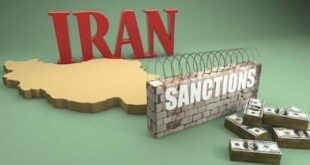The Art of Sanctions – Defining Terms: Certainly, it is easier to defend the negative impacts on the sanctioned jurisdiction by arguing, with some plausibility, that these effects are not solely to do with sanctions or—even better—that only the desired negative effects stem from sanctions. Such a framework allows a sanctioner to avoid claiming responsibility for humanitarian problems stemming from sanctions, while making the connections clear when claiming credit for sanctions’ benefits.
Mauood’s Introduction: The author of the present book (The Art of Sanctions) is Richard Nephew. Richard Nephew was in charge of the sanctions team against Iran during Obama’s second term. He supported the nuclear negotiators in the matter of sanctions in Vienna. Richard Nephew has previously served for ten years as an Iran member of the National Security Council at the White House and as Deputy Secretary of State for Coordination of Sanctions at the State Department. The book is also translated into Persian by the Iranian Parliamentary Research Center (IPRC).
Note: The content of this book is not approved by us and is published solely to familiarize policymakers with the views, approaches, and methods of the designers of sanctions against Iran.
Defining Terms
most people you meet on the street can offer a workable definition of sanctions. They can identify the elements of sanctions—for example, prohibiting trade in particular items or in total—or they can describe the desired economic result, such as “preventing a country from engaging in normal business activity.” But at some point, most definitions will mix the concept of penalties and consequences with the overarching system of rules and obligations that interfere with normal economic activity.
This conflation adds to the confusion about what “sanctions” constitute and how to ascertain their effectiveness. Let’s take a concrete example: the United States has an extensive set of “sanctions” against Iran, even after the January 2016 implementation of the Joint Comprehensive Plan of Action (JCPOA). But the United States also imposes “sanctions” on individual actors identified as having violated “sanctions.” And the United States imposes “sanctions” on individual actors who help others engaging in “sanctionable” conduct, which is itself a violation of “sanctions.”
Another example shines a spotlight on the problems created by this semantic confusion: if “sanctions” refers both to an individual fine of several thousand dollars and an institutionalized set of rules and obligations governing trade between two major economies, then it is plainly more difficult to ascertain subsequently whether “sanctions” worked in a particular situation.
“Sanctions” may have worked quite well in harming the business and reputation of the firm fined several thousand dollars, while “sanctions” also failed miserably in impeding the effort of a sanctioned country to support terrorism. To borrow a military allusion, this terminological problem is the equivalent of confusing the effectiveness of an army division with the overall progress of a war. The division may be successful while its comrades fail or vice versa, but the distinction certainly matters, in real life and in analysis.
To develop a strategy of sanctions, we must therefore understand what is meant in all uses of the word. Starting with the highest level of abstraction, sanctions are defined in this book as the constellation of laws, authorities, and obligations laid out in a piece of legislation, government decree, UN resolution, or similar document that restrict or prohibit what is normally per-missible conduct and against which performance will be assessed and compliance judged.
A synonym for sanctions in this usage is sanctions regime. In this framework, the “imposition of sanctions” should be read as creating a set of systemic, overarching rules of behavior. Violations of sanctions are therefore also to be read as contravening the overall sanctions regime by breaking the specific rules and terms.
Notably, these rules can cover all sorts of activity, not just economic activity. For instance, the UN Security Council (UNSC) has often used the imposition of travel bans as a way of applying pressure against individuals and their governments. These bans are hardly of economic value (at least in most instances), but they are applied nonetheless as a way of creating new restrictions governing the target.
Likewise, such sanctions can also be framed around the denial of particular goods—such as those needed for the Iranian or North Korean missile programs—where the overall economic impact may be slight, but the strategic value is significant. For this reason, I modify the use of the term sanctions when appropriate to characterize the scope of the measures, whether the sanctions are economic, technological, or personal. Likewise, I will avoid using the term sanctions to define the direct imposition of penalties or consequences for a violation of the overall regime, preferring instead to describe them as penalties or consequences.
Why Impose Sanctions?
Sanctions are intended to create hardship—or to be blunt, “pain”—that is sufficiently onerous that the sanctions target changes its behavior.
Using pain as the specific word for the objective may seem provocative, loaded as it is with imagery of torture and abuse. Yet, pain is a useful term precisely because it is evocative; as a common human experience, people can instinctively appreciate what sanctions incur as well as the desire to avoid the resulting “pain.” For this reason, I am not the first to use pain in this context.
Pain as a term underscores both the purpose of sanctions and their inherent limitations. Pain causes discomfort that most people seek to avoid, but it can also be managed, tolerated, and—over time—potentially adapted to, even to the profit of its recipient.
Of course, the physical dimension of pain is less pronounced in sanctions, certainly as they have been practiced over the past decade with an increased emphasis on avoiding the curtailment of humanitarian trade, even with heavily sanctioned jurisdictions.
In fact, the type of pain and its severity may be modulated, but the intention of sanctions is always to make the new status quo uncomfortable and unpleasant for the target. Sanctioned persons are expected to find the discomfort sufficiently onerous that they’ll do something different. In this way, sanctions are a form of violence.
Pain avoidance is a significant impulse for the individual and, scaled up, for societies. Translating this basic impulse into a subject for international affairs analysis entered its heyday with the bevy of nuclear strategy manuals published in the 1950s. One of the foremost theorists of nuclear deterrence, the late Thomas Schelling, began his seminal work Arms and Influence with the observation that “the power to hurt—the sheer unacquisitive, unproductive power to destroy things that somebody treasures, to inflict pain and grief—is a kind of bargaining power, not easy to use but used often.”[1]
He goes on to note that “hurting, unlike forcible seizure or self defense, is not unconcerned with the interest of others. It is measured in the suffering it can cause and the victims’ motivation to avoid it.”[2]
Schelling was speaking primarily of the use of military force as a motivating factor, as opposed to sanctions, but the concepts are essentially the same. So too are concepts of resolve, which Schelling dubs at one point “endurance.”[3] They relate to a country’s ability to absorb pain and still maintain its ability to function. In many cases, this is described in military terms, but as with pain, this ability need not be: the ability of an economy to continue functioning despite losing a major part of its productive capacity is analogous to an army continuing to fight despite losing a division.
Because of the different practical effects of sanctions and military force, however, policymakers treat these two tools far differently. Military conflict creates casualties and damage for each side, and the results are visible for all to see. The impact of sanctions can be less visible and may seem less destructive, certainly on a visceral level.
This no doubt explains part of the attractiveness of sanctions as a tool of force: it is preferable by far for a politician or national security official to accept and defend the loss of 1/4 percent of GDP than it is to accept and defend the loss of a thousand military servicepeople and civilians. But on a strategic level, the imposition of pain via sanctions is intended to register the same impulses in an adversary as those imposed via military force: to face a choice between capitulation and resistance, between the comparatively easy path of compromise and the sterner path of confrontation.
And just because the damage wrought by sanctions may be less visible (at least, with some sanctions regimes), it need not be less destructive, particularly for economically vulnerable populations that may be affected.
Big changes in policy—such as giving up a claim to a territory—may require more pain than smaller changes in policy, such as stopping arms trade with an insurgent group. But sanctioning countries may not be totally aware of the scope of the measures they intend to pursue, miscalculating at times as the resolve of their adversary and whether the pain inflicted is having the intended effect.
Deciding how to impose pain that is effective (and, hopefully, efficient) is an issue for intelligence analysts and sanctions experts. But at the root of their efforts is the desire to inflict some measure of pain in order to change policy, as well as an inclination to match pain levels with the desired outcome.
Unfortunately, those entities imposing sanctions often downplay this concept of imposing pain, at least with respect to anyone other than the desired target. The reasons are myriad but, in my experience, were largely to avoid ownership of humanitarian consequences. As we shall see in later chapters, the emphasis in the United States on the targeted aspect of sanctions after a period of excess in Iraq in the 1990s is a manifestation of this desire.
Sanctions literature has, possibly inadvertently, helped contribute to a perception of relative bloodlessness of sanctions after Iraq, contrasting new “smart” sanctions with presumably old “dumb” sanctions.
Certainly, it is easier to defend the negative impacts on the sanctioned jurisdiction by arguing, with some plausibility, that these effects are not solely to do with sanctions or—even better—that only the desired negative effects stem from sanctions. Such a framework allows a sanctioner to avoid claiming responsibility for humanitarian problems stemming from sanctions, while making the connections clear when claiming credit for sanctions’ benefits.
The U.S. government has maintained for years that, since its sanctions policies target the Iranian government and bad actors, its responsibility is minimal for any humanitarian problems resulting from economic pressure applied. But such claims do tend to ring hollow when considered simply and without the artifice of policy analysis. After all, if you intentionally reduce a country’s ability to earn foreign currency through exports, then you will almost by definition create at least some pressure on imports, including of food and medicine.
True, a sanctioner can always point out that it is the responsibility of the sanctioned country to manage its imports and even to avoid the entire confrontation. But this does not mean that sanctions were not painful, including at the street level, or that the sanctioner is innocent of having created any resulting crisis.
Moreover, the irony of all this is that sanctions are ultimately intended to cause pain and change policy: denying some of that pain may make for better public relations for a sanctions program, but it also undermines the contention that sanctions work and may even interfere with their effectiveness on a practical level if a sanctioner adjusts the regime to address a humanitarian problem and, in doing so, reduces the very pain the sanctions are intended to create.
This leads to a fundamental set of questions: how do you tailor sanctions to achieve their objectives with the minimum necessary pain on the sanctioned target? How do you undermine willingness to endure this pain when the target has already been informed that the desired effect is bounded? How do you communicate readiness to exceed the amount of pain established to break down this resolve? And is there an optimal point at which pressure has been brought to bear sufficient to achieve your desired result, without having to go farther?
What Is Resolve?
The answer to these questions lies in an understanding of the impact of sanctions and their pain on the targeted state, particularly the response of the sanctions target and how it accepts, resists, or works around the pain being imposed by the sanctioner.
I will use the term resolve to capture the overarching concept of a target’s response to sanctions and readiness to continue with its objectionable activity. In this way, resolve is perhaps defined best as the simple, psychological determination of the sanctioned state to deny victory to the sanctioning party and to persevere with its chosen path.
This determination can come from many sources—including a desire to avoid whatever disruptions may come from deviating from present policy—but the key factor is the degree to which the target believes that its present approach is better than the sanctioner’s identified alternative despite obvious pressure to change course. And, in fact, sanctions are themselves intended to undermine this psychological determination, both by undermining its physical basis (for example, if a target fears the economic damage of acceding to the sanctioner’s desired approach, then a sanctioner escalates the economic damage of not acceding to the sanctioner’s desired approach) and the target’s willingness to absorb it (for example, by making acquiescence to the sanctioner’s demand seem inevitable).
States can undertake a variety of strategies to manage or com-bat inflicted pain. They can accept the pain, making do with the impact of it and carrying on regardless. They can reject the pain, seeking to evade the impact of sanctions through smuggling or erection of power blocs opposed to the imposition of sanctions in the first place. And, in a hybrid approach, states can adapt to the pain, absorbing it where necessary and taking advantage of its consequences where possible to identify new areas of economic activity or political cooperation.
As this is a book on the strategy of sanctions rather than sanctions rejection, the focus of the following analysis is on how sanctioners experience and respond to demonstrations of resolve, seeking to overcome them and manage their own problems with commitment, expressed most often as “sanctions fatigue.” But, as these pages will show, without a solid understanding of how states struggle against the imposition of pain, sanctioners are impaired in their ability to define and implement effective sanctions. As Ned Lebow pointed out in the conclusion of Psychology and Deterrence,
policy makers who risk or actually start wars pay more attention to their own strategic and domestic political interests than they do to the interests and military capabilities of their adversaries… [T]hey may discount an adversary’s resolve even when the state in question has gone to considerable lengths to demonstrate that resolve and to develop the military capabilities needed to defend its commitment.[4]
It does not take much imagination to substitute Lebow’s military terms with economic terms in order to see that a close parallel can be made with those who impose economic force or any of the other forms of pressure that sanctions can bring. As with the use of military threats, the encapsulating strategy in which sanctions are imposed cannot hope to succeed if there is a misunderstanding of the natural and adopted resolve levels of sanctions targets.
For such an important element of sanctions-related theory, resolve is neither readily understood nor accommodated in most sanctions programs. Instead, resolve can be sometimes treated as a routine commodity, with equal weight given to different sanctions tools across different contexts. It may often be assumed, for instance, that depriving any country of gasoline will lead to not only economic but also social crises, perhaps because—from an American-centric view—taking away the ability to use automo-biles at will is a violation of a God-given right. But for a country where the primary personal means of public transportation is electrically driven trains, the impact of a gasoline ban may be far less severe.
Discussions of sanctions imposition sometimes assume that an adversary will experience the same pain as the sanctioner would perceive should the tables be turned. But such an approach misses the cultural, economic, political, and broader social dynamics that might change the impact of sanctions. These factors have real salience. They can represent the difference between sanctions achieving their intended objective or failing. And, in some cases, failure to consider national circumstances carefully could even lead to sanctions being imposed that create greater resolve in the targeted state than otherwise could be expected or—for that matter—sanctions being imposed that are perversely welcomed by their target for domestic political or economic reasons, or even to improve their position internationally.
This last reflection lends emphasis to a central problem of sanctions as a foreign-policy tool: a lack of understanding as to whether the pain imposed by the sanctioner has the intended impact on the target state, as well as how the targeted state will choose to respond. This problem plagues many different elements of foreign policy decision making, but perhaps with no worse a negative impact than in the realm of sanctions, where the psychological battle between opponents is the most pronounced. While military force also requires consideration of psychological resilience and will, ultimately it can render an opponent physically incapacitated even should the opponent’s resolve never falter.
This is far harder to achieve via sanctions, particularly in an increasingly globalized world with goods available from a variety of providers and with video cameras, Twitter, and Instagram available on every phone.
With sanctions, states are almost always placed in a game of chicken, each daring the other to swerve and with damage resulting to both parties from the conflict. For the sanctioned state, the impacts are part and parcel of the sanctions themselves. For the sanctioning state, the impact is often subtler but could involve economic harm, diplomatic disruption (as the sanctions regime demands senior-level focus to maintain it and constant engagement with sanctions partners to keep them on-side), and the creation of an escalating commitment trap, in which a state feels it cannot walk away from the sanctions regime without achieving victory, lest it lose credibility in any future crisis.
A crucial element in the imposition of sanctions is therefore the understanding of relative levels of national resolve being brought to the table and what kind of steps can be taken to reduce them.
In the end, I conclude that knowledge of one’s opponent, their tolerances, and their vulnerabilities is the most important pre-dictor of a sanctions-focused strategy’s chances for success. All too often, sanctions advocates conflate their own desire to demonstrate their commitment to sanctions with considerations of resolve in their targets.
Advocates assume that to fail to act is to show weakness and that the tougher the action, the better. In such a simplistic, naïve, and misguided fashion, sanctions advocates fall into a trap that military strategists throughout history and across cultures have drilled into their acolytes: failing to understand their opponent fully before committing to the field. In fact, for sanctions to work, one must actually know one’s enemy better than the enemy knows itself.
The United States has both succeeded and failed at this task in the past. But to understand how current sanctions practitioners work through this problem, we must first examine a critical failure: that of the sanctions regime against Iraq from 1990 to 2003.
Footnotes:
1. Thomas Schelling, Arms and Influence (New Haven, CT: Yale University Press, 1966), v.
4. Richard Ned Lebow, “Conclusions,” in Psychology and Deterrence, by Robert Jervis, Richard Ned Lebow, and Janice Gross Stein (Baltimore: Johns Hopkins University Press, 1985), 216.
 Mouood Mouood English Edition
Mouood Mouood English Edition




